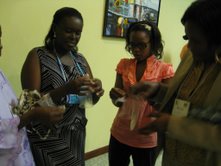Uganda to Reintroduce Female Condoms
The Ugandan government plans to reintroduce and promote the female condom this fall, where it may give women another tool for safer sex negotiation and protection.
"When a man comes up with
excuses for not using a male condom, women have a right to introduce
their own tool for protection."— Deusdeait Kiwanuka, Project
Coordinator, Safe Homes and Respect for Everyone (SHARE)
Deusdeait’s words poignantly
capture a major challenge in fighting HIV/AIDS: to ensure women have
access to prevention tools designed to put them in charge and give them
an opportunity to initiate protection. Enter the female condom – the
only safe and effective prevention tool that is designed for women to
initiate and is available for use NOW. But "available for use"
doesn’t necessarily translate into "accessible to women" – whether
in the U.S. or abroad.
Consider Uganda, where the
Ministry of Health reports that 76% of the country’s new infections
are sexually transmitted and women make up 60% of those infected.
Moreover, 42% of new infections occur in marital sex. These sobering
statistics cry out for expanding prevention options that put women in
the driver’s seat. Despite this, women and their partners currently
have no access to female condoms in the country.
Fortunately, the tide is turning
for women, men and youth who could benefit from the female condom. The Ugandan government plans to reintroduce and promote the female condom
this fall, and civil society leaders in Uganda see this as an opportune
moment to accelerate investment and support in this initiative.
Last week, the Center for Health
and Gender Equity
(CHANGE) and the Global
Campaign for Microbicides
(GCM) – both US-based organizations advocating for the availability and accessibility
of a range of prevention options for women worldwide – convened local
leaders from HIV/AIDS, reproductive health, domestic violence, human
rights and women’s rights groups in Kampala for an advocacy training
targeted at donors and national government to ensure successful reintroduction
of female condoms in Uganda. As part of the training, participants met
with members of the Health Development Partnership Group, which USAID
heads; with UNFPA and the Ministry of Health, demonstrating civil society
support for the prevention method. Participants also learned about
the history of the female condom in Uganda and how to move forward with
advocacy efforts beyond the training.
The training was opened by
Mr. Benard Mujuni of the Ministry of Gender, Labour and Social Development,
who made the case for women’s access to currently existing prevention
methods such as female condoms – and future products such as microbicides – as
a human rights and reproductive rights issue. But in order for
female condoms to succeed today, in Uganda and elsewhere, civil society
must be full partners in any launch or rollout of female condom programming.
Vastha Kibirige, coordinator
of the condom unit at the Ministry of Health, underscored this point
by providing an overview of the Ministry’s situation
analysis of the
female condom in Uganda that was released earlier this year. Kibirige
explained how the first introduction of female condoms in Uganda in
2000 was not successful, but this was not because of the product. Civil
society was not actively engaged in the first rollout of female condoms,
and a lack of resources and sustained support for distribution, education
and programming, made the existence of the product useless.
Accessibility issues explained
by Kibirige posed very real problems for many women. For example,
a participant from the Center for Domestic Violence Prevention recounted
how domestic violence fuels women’s requests for female condoms in
situations of martial rape. Sometimes, when these women are able
to negotiate condom use, men come up with excuses or resist using male
condoms. Her clients say that if they had female condoms with
them, they could put them on before they have sex, giving them an additional
tool for negotiation and protection.
This is not to say that female
condoms are a magic bullet or that access alone will ensure successful
use and uptake. But the group did highlight the concept of "universal
acceptability" – a different way to think about and advocate around
female condoms. This frame calls for removing stigma and biases
often associated with female condoms, allowing men, women and youth
to freely choose female condoms as a legitimate prevention option.
Finally, against the backdrop
of our discussions around women’s high risk of infection from marital
sex and lack of access to female condoms, it was interesting to note
PEPFAR’s abstinence and fidelity impact on Uganda. In our shuttle
bus to meet with USAID and other donors in the Health Development Partnership
Group was a bumper sticker with wedding rings, stating "Stop AIDS.
Keep the Promise," "Be Faithful in Marriage." It’s clear
that much more work needs to be done.

Let’s hope the Obama administration,
especially the new global AIDS coordinator and USAID administrator will
turn the tide for women and men and young people in Uganda by supporting
the Ministry of Health’s efforts to save lives by making female condoms
accessible.

